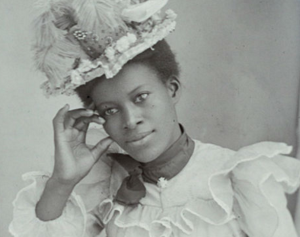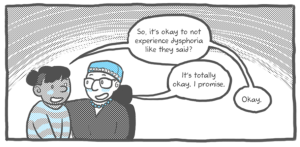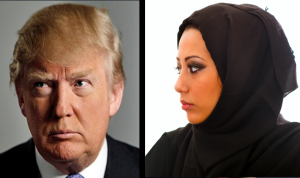Have you ever wondered why people say “I don’t see color” as a way to “fix” racism? Yeah… that doesn’t work.
On this show, we talk about race all the time, but I’ve got a bomb to drop: Biologically speaking, race doesn’t exist. Oh my goodness! We’ve all been lied to! Wait, why am I hosting this show? So race isn’t biological, but the social constructs of race and racism still have a very real impact on everyone’s lives.
And this isn’t just about feelings. Race is all about the structural foundation of social power. So why do so many people incorrectly think race is biological? Well, beyond the fact that we like to group people based on external characteristics, it goes like this: In biology, there is a concept of genetically different subspecies, which a lot of people confuse with human races.
Biologists actually have a scale for this, and humans don’t even come close to qualifying. Throughout history, people have used this incorrect understanding of subspecies to justify all kinds of terribleness – and even proclaim other races as less than human.
But modern genetics has shown that the lines around “race” are so arbitrary that they’re actually meaningless. And since I’m not a scientist, I’ll take a quote. Francis Collins, the director of the National Genome Research Institute, said it himself: “Those who wish to draw precise racial boundaries around certain groups will not be able to use science as a legitimate justification.”
Oops! I dropped the mic.
So if race doesn’t exist biologically, why do we keep talking about it? Sound the alarm. We keep talking about race because we created it. Yay, us! That’s right – race is a social construct.
A social construct is a category, perception, or idea created and developed by society and then applied to individuals or groups. But social constructs are still very real and have huge impacts on our lives.
Because you know what else is a social construct? Money. And if you don’t think money has an enormous impact on your life, and if you don’t think has an enormous impact on your life, well, then congratulations, you either have a trust fund or you’re an adorable baby. Or maybe you’re a dog.
“Here’s what I know: Talking about racism just creates more racism.”
Uh, no. First off, race isn’t the problem; racism is. And even if it was the problem, problems don’t get worse when you talk about them. And they don’t magically go away when you ignore them.
“Uh, not true. I had five cavities, and I ignored them, and all five of these teeth fell out. Poof, problem solved.”
Colorblindness is nice in theory, but it has no effect on structural and institutional racism. Racism is a system, and that system benefits certain people at the expense of others. Ignoring it just lets those problems persist. Don’t believe me? Let’s take a look at some examples where colorblindness doesn’t work.
1. Preschool Punishment
Let’s face a fact: preschool age children of every race are monsters. But according to the US Department of Education Office for Civil Rights Report released in 2014, Black children make up 18% of preschoolers, but almost half of all suspensions. Half!
I don’t think anybody believes all these preschool teachers are racists out to get little Black children. But the data shows that Black and Latino children often face steeper punishments than their white classmates for the same behavior. That’s a problem. And simply believing we shouldn’t talk about race does nothing to solve this problem.
2. The Name Study
A study by the National Bureau of Economic Research confirmed that people with “ethnic-sounding” names – that’s a whole ‘nother episode – are less likely to get interviewed when they apply for a job.
Meanwhile, applicants with “white-sounding” names actually get 33% more callbacks for interviews. It’s the equivalent of having eight years of additional experience. Shout out to all the white Daquans struggling to get job interviews!
And it’s not just Black and white. They’ve done similar studies around the world. And in Canada, people with white-sounding names were 35% more likely to get callbacks than people with Indian-sounding names or Chinese-sounding names.
So instead of just assuming people shouldn’t care about color or names, companies, governments, and schools should take the bias out of hiring and experiment with nameless resumes to—you know—solve the problem.
3. Renting an Apartment
When the Department of Housing and Urban Development explored real estate, they found that Black, Latino, and Asian renters were up to 12% fewer units than white renters. And when the Fair Housing Justice Center used actors to apply for apartments, they found that Black and Latino renters were often told there were no apartments available, while white applicants were shown apartments in the same building.
“So this building has a pool, a laundry room, and a racist landlady!”
Colorblindness won’t fix housing discrimination; we’re going to need smart laws and a concerted effort for that.
So tell me again how colorblindness is gonna fix the fact that I can’t get an education, a job, or a house. In many cases, colorblindness is actively harmful because it creates a false sense of security for the groups it directly benefits. The people who’ve benefitted from systemic racism can assume that they got the job or a house or weren’t suspended from preschool because they were more qualified or just better.
Ignoring race or only acknowledging that it doesn’t exist biologically is not a solution to these systemic issues. It takes work, effort, laws, and new systems to undo racism. These differences may seem minute, but they’re part of a very large structure of oppression that’s been ingrained in us. If we can understand that we made it up, we can actively work to change it.
Thanks for watching. We’ll see you next time right here on Decoded.




















